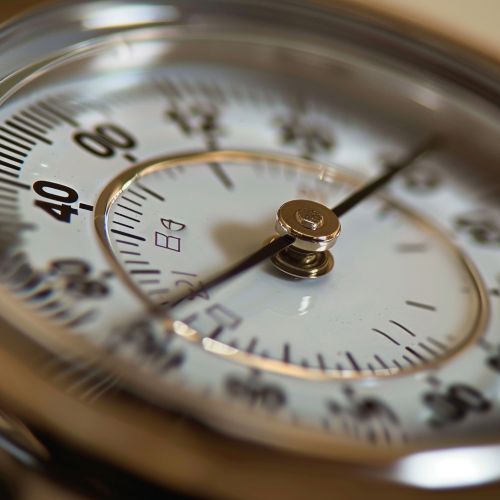Thermometer
Introduction
A thermometer is a scientific instrument used to measure temperature. It is a crucial tool in a wide range of fields, including physics, chemistry, medicine, and meteorology. The term 'thermometer' is derived from the Greek words 'thermo' meaning heat and 'meter' meaning to measure.
History
The concept of measuring temperature dates back to the ancient Greeks. However, the first modern thermometer was invented in the 16th century by Galileo Galilei. Galileo's device, known as a thermoscope, was a rudimentary instrument that could only show changes in temperature, not specific degrees. The first true thermometer, which used alcohol and had degree markings, was developed by Daniel Gabriel Fahrenheit in the early 18th century. Fahrenheit also introduced the Fahrenheit scale, which is still widely used in the United States today. The Celsius scale, another common temperature scale, was developed later in the 18th century by Anders Celsius.


Types of Thermometers
There are several types of thermometers, each with its own specific uses and advantages.
Liquid-in-glass Thermometers
Liquid-in-glass thermometers are the most common type of thermometer. They consist of a narrow glass tube filled with a liquid such as mercury or colored alcohol. When the temperature changes, the liquid expands or contracts, moving up or down the tube. The temperature can then be read from the scale marked on the tube.
Electronic Thermometers
Electronic thermometers, also known as digital thermometers, use electronic sensors to measure temperature. They are often used in medical settings because they can provide fast and accurate readings.
Infrared Thermometers
Infrared thermometers measure temperature by detecting the infrared energy emitted by an object. This allows them to measure temperature from a distance, without needing to touch the object being measured.
Bimetallic Strip Thermometers
Bimetallic strip thermometers consist of two different metals bonded together. The metals have different rates of expansion, so when the temperature changes, the strip bends. This bending can be used to move a needle on a dial, indicating the temperature.
Temperature Scales
There are three main temperature scales used today: Fahrenheit, Celsius, and Kelvin. The Fahrenheit scale is used primarily in the United States, while the Celsius scale is used in most other countries. The Kelvin scale is used primarily in scientific contexts.
Fahrenheit
The Fahrenheit scale was developed by Daniel Gabriel Fahrenheit in the early 18th century. On this scale, the freezing point of water is 32 degrees, and the boiling point is 212 degrees.
Celsius
The Celsius scale, also known as the centigrade scale, was developed by Anders Celsius in the mid-18th century. On this scale, the freezing point of water is 0 degrees, and the boiling point is 100 degrees.
Kelvin
The Kelvin scale is an absolute temperature scale, meaning it starts at absolute zero, the theoretical lowest possible temperature. On this scale, the freezing point of water is 273.15 Kelvin, and the boiling point is 373.15 Kelvin.
Applications
Thermometers have a wide range of applications, from everyday uses to specific scientific and industrial applications.
Everyday Uses
In everyday life, thermometers are commonly used to measure body temperature, indoor and outdoor air temperature, and the temperature of food and cooking appliances.
Scientific Uses
In scientific research, thermometers are used to measure temperature in various experiments and studies. This can include measuring the temperature of chemical reactions, studying the behavior of materials at different temperatures, and monitoring environmental conditions.
Industrial Uses
In industry, thermometers are used to monitor and control the temperature of various processes. This can include controlling the temperature of manufacturing processes, monitoring the temperature of stored materials, and ensuring the proper operation of heating and cooling systems.
